Pita Pocket Bread Recipe
This recipe came from a friend of mine. It’s a recipe that once you try it, you won’t want to purchase the pita bread from the store anymore. These pita pocket are so fresh and delicious and really not very hard to make at all.
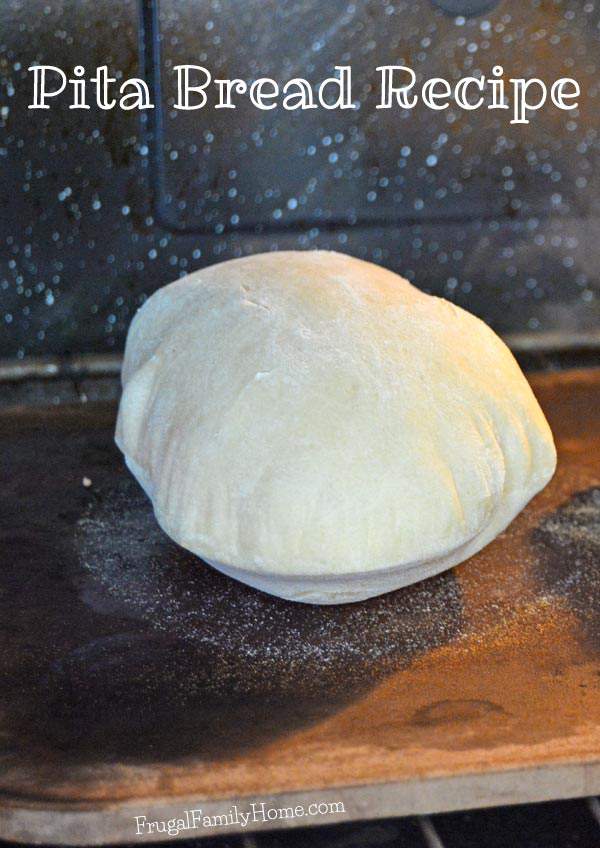
The main thing you want to make sure to do is to have a nice hot oven. You need the oven really hot, as hot as it will go to get the pocket bread to puff properly. I have found using my baking stone on the lowest rack in the oven works really well to get them to puff properly.
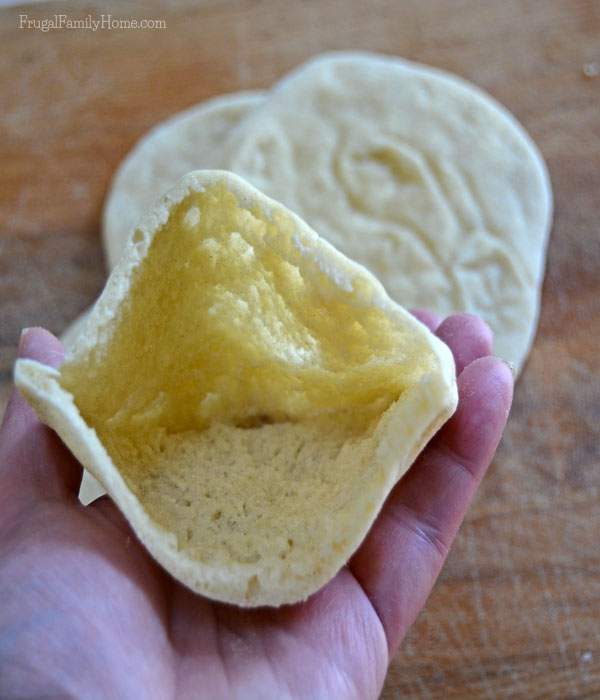
I also make sure to let the oven get back up to temperature before adding another batch of pittas. All of these steps help to ensure proper puffing of the bread and no sticking in the middle.
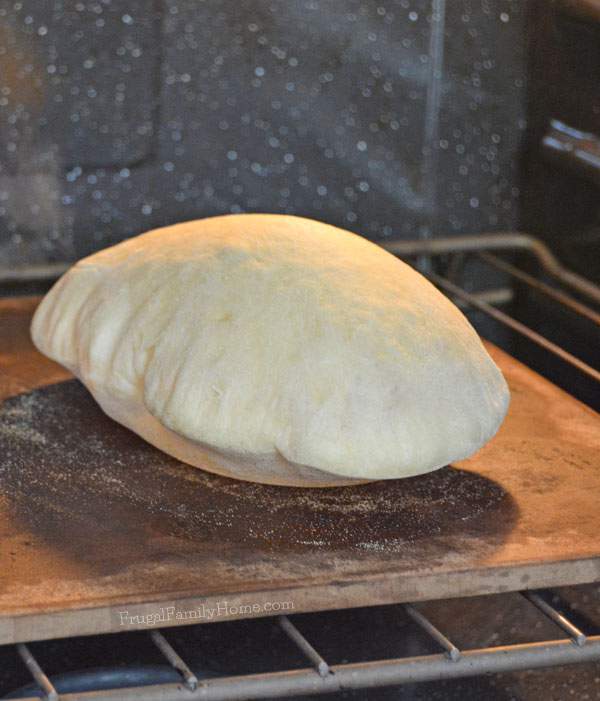
You also need to watch for browning. If the bread is getting brown at all it’s been in the oven too long. It only take a few minutes for the bread to bake. I have over baked a few in the past and they turn out to be more like crackers than bread. So you definitely don’t want any browning at all.
Mixing up the dough is like any other bread. The dough needs to be drier, not sticky at all, so be sure to use enough flour while kneading.
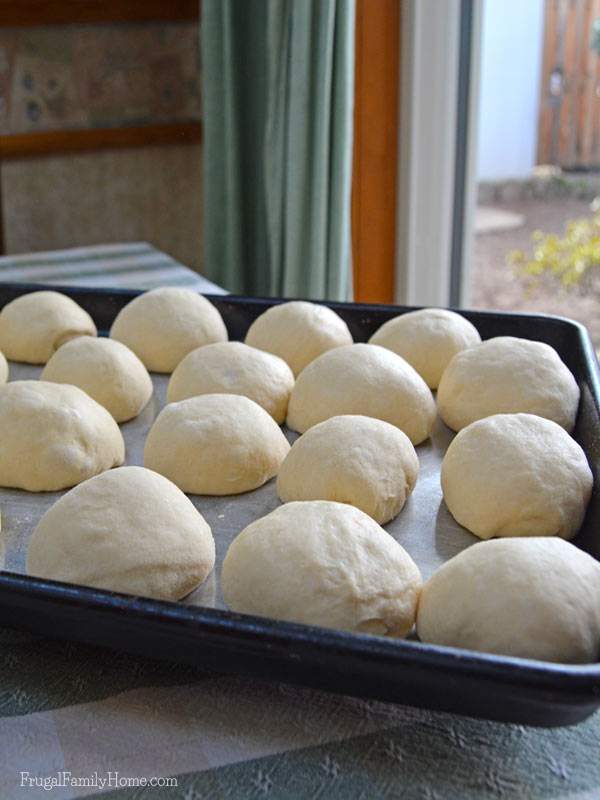
Let the dough rise then punch it down and shape into balls. Let the balls of dough rise again. I usually let my oven and stone heat up during the second rising to ensure it is nice and hot when I ready to bake the pittas.
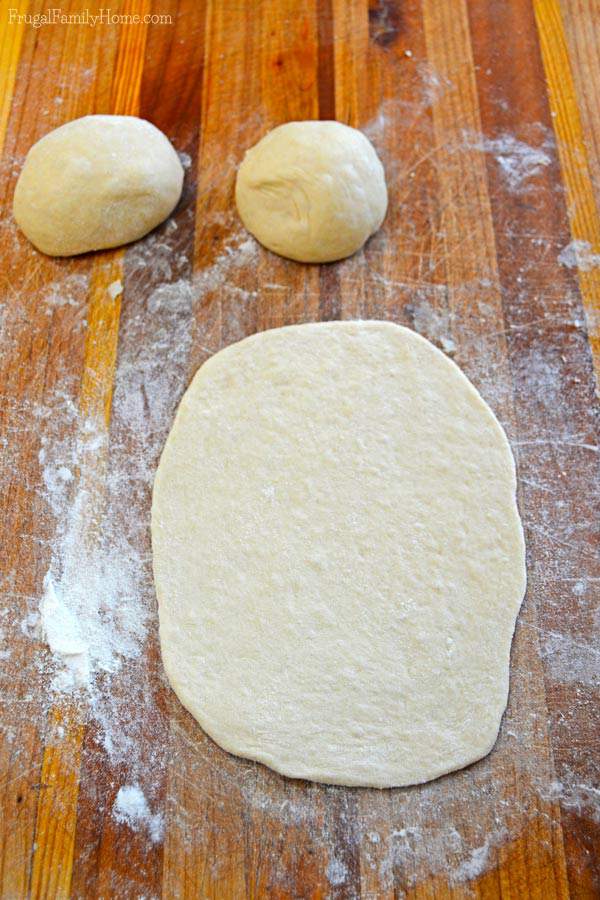
I roll the dough out fairly thin and place them on the pizza peel. I usually bake two pittas at a time. Once in the oven I watch them closely. As soon as they are both puffed nicely out they come. Remember you don’t want any browning at all.
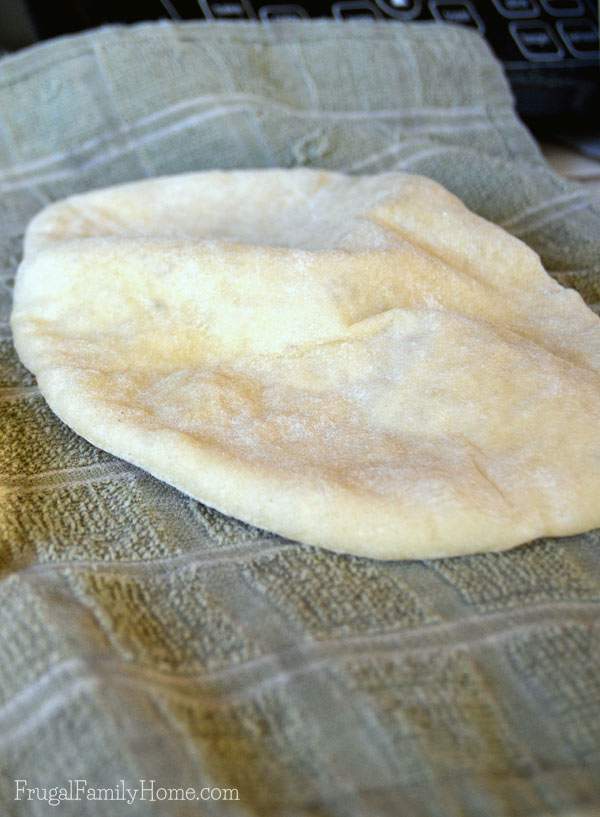
To deflate and cool, I place them in a dish towel while I work on the rest. Once cool I cut the pittas in half. If any have stuck together I carefully loosen them with a knife. I have had good success with freezing the pittas. I will usually freeze them in meal sized portions, wrapped in plastic wrap and sealed in a gallon size freezer bag.
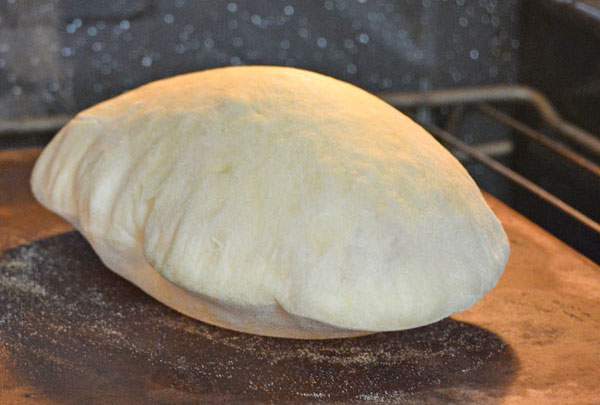
Pita Pocket Bread Recipe
Ingredients
Instructions
- Mix yeast, sugar and warm water in a large bowl. Stir to dissolve yeast and let sit about 5-10 minutes.
- In another bowl mix the milk, salt, and hot water. Add to the yeast mixture and stir to combine.
- Add in the flour a cup or two at a time and mix well. You want the dough drier and not sticky.
- Knead dough for about 5 minutes.
- Cover and let rise 30 minutes.
- Punch down and divide into 1/2 cup balls, about 12-18 balls.
- Cover balls and let them rise for 30 minutes. I rise mine on a cookie sheet.
- While dough balls are rising preheat the oven to 500 degrees. If you have a baking stone put it on the lowest rack and let it preheat too. You want the oven very hot to get the bread to puff properly.
- After dough balls have risen, take a ball and roll it out into an oblong shape. Place on a floured cookie sheet or pizza peel.
- Bake the pocket bread for 3-5 minute or until puffed but not brown at all, on a cookie sheet or baking stone. If the dough starts to brown before fully puffed remove from the oven.
- I bake two pita pockets at a time in my oven on my baking stone. If you don’t have a stone a cookie sheet will work too.
- After removing the pocket bread from the oven, place in a dish towel to deflate and cool.
- Once cool cut in half. If the two layers stick use a knife to carefully separate the layers.
- The pita bread can be wrapped in plastic and frozen for later use.
What’s your favorite type of bread to make? I would love to hear if you are planning on trying to make your own pita bread. Leave me a comment below and let me know.
If You Like this Recipe
Subscribe and you'll get Recipes
sent right to your inbox!
Click the button below and fill out the form.


After close to 8 cups of flour my dough was still very sticky! Not sure what went wrong but I have to say I gave up since there was no way to work with such sticky dough…
Sandra, I’m so sorry to hear that. I wish I knew what went wrong for you. I’ve never had a problem with the dough being so sticky or needing so much flour. Sometimes on very wet rainy days, I need to add an extra cup of flour. But 8 cups should have been enough. Maybe try reducing the water a little next time? Maybe that would help.
Possibly misread the liquid measurement? Or mis counted the number of cups of flour
(Easily happens).
My family loved this recipe!!! I made the dough in my bread machine which worked amazing. My 4 year old helped roll the pitas and she ate 2 as soon as they were cool enough for jam! I’ll have to make another batch soon because these won’t last long!
Jill, I’m so happy your family loved the recipe! 🙂 ~Shelly
@Sandra – I wonder were you using a stand mixer to knead? I used a stand mixer to add flour cup by cup, and after almost 8 cups were added mine was also slack and extremely sticky. In frustration, I dumped it out on the counter and incorporated an additional half cup by hand and it came together much better. I’m thinking that the stand mixer is just not efficient at mixing this dough since it is such a large volume
same here! and I also used a mixer… I wonder if that is the issue
Made last night had no issues with the directions. Made by hand like I do all my breads. Turned out very well. Thank you.
Your welcome, Mike.
This recipe looks delicious and I can’t wait to try it. A question for yourself and the overall community – has anyone tried baking these on a cookie sheet or something other than a baking stone? Thanks!
Val,
I’ve baked them on a cookie sheet before but I’ve found a baking stone works a little better. If you use a cookie sheet make sure to put the rack in the lowest position in the oven and cook there so the pan will get nice and warm to help puff the bread. I hope that helps.
@ Val: I made them today on the back of a pre-heated (30 mins) cookie sheet, and they turned out great. I just had to take them out at exactly 2 m 20 secs before they browned more at the bottom. I always used a naan recipe when I needed flat, easy bread in an hour or so, but I decided to go with this recipe today. I halved everything since I was not sure how things would turn out:)
@Shelly: Thanks for the recipe, and as the answer to your “other bread” questions, I do make Challah Bread once a week or so, and Naan Bread almost every morning, and they both turn out awesome especially if you toast the challah in the toaster-oven the following morning.
Ever tried this recipe with Gluten free flours? I am not asking for how-to’s of cooking Gluten free, just simply asking if it has worked out with those GF flours. Thanks.
I haven’t tried it with gluten free flour before. Sorry I couldn’t be of more help.
My pita turned out great although I wish it had puffed up more in the oven! Like others have said I had difficulty getting pliable dough. It was still very sticky after 6 cups and I ended up adding significantly more flour until I got a pliable, non-sticky dough.
Meg, I’m glad your pitas turned out great.
I sometimes have to use a lot more flour to keep the dough from being sticky and other times I use less flour. It really does depend on humidity, time of year, the total amount of flour changes for me too. I try to give a guide but maybe I need to update the recipe to say you may need more flour. And some readers in drier climates might need to use less than six cups. So many things can affect the total amount of flour needed.
I’ve found the best way to get them to puff in the oven is to bake them on the lowest rack in the oven on a stone that has been heated up while the dough balls are rising.
Thanks for your feedback on the recipe. I’m making a batch this weekend for us and I’ll see how much flour I use this time around since it will be wet this weekend. Then I can more accurately give a range of flour to use.
Hi …I have tried making it but im having an issue with making it raise …can you please tell me what went wrong …I followed the recipe and its not raising.
Lauren, There could be a few things that happened. How warm was the water you used? If it’s too warm the yeast could have been killed. It needs to be around 120 degrees. Also if the yeast is old, it may not rise. Yeast becomes less active when it gets old. That could be the other cause for it not rising. Or if the dough isn’t placed in a warm enough spot. If you keep your house cool like we do you might need to place the bowl to rise in an oven that has been warmed up a bit. I’m assuming you are talking about step 5 where you let the dough rise 30 minutes? Just wanted to double check to make sure. I hope one of these tips can help.
This is my new go-to recipe, it has always worked out perfectly! Beautiful pocket, lovely and light chew. Thank you for sharing!
So glad you liked the recipe Denise.
Hi Shelly,
Thanks for the recipe. I don’t get pockets in all my pitas (hot stone, bottom shelf…oh, well) but, I do have a better percentage of pockets than I have had with other recipes.
About the flour issue…first I too have to add about 2 cups of extra flour. I live in Southern California and its been warm and dry each time I’ve tried your recipe, so its not just humidity. I was wondering, how do you measure your flour? Do you scoop it up with the cup or spoon it into the cup. If you scoop the flour is compacted and it may account for the large differences. Its a thought anyway.
One other thing, its about Lauren’s dough not rising. You add water in the recipe in two different places, initially you say to add warm, 120 degree water. When you add the 2 C of water later, the directions say that it should be hot. In my experience, 120 degrees is at the upper end for water temperature. If Lauren assumed that hot meant significantly higher than 120 there’s a real good chance that she killed her yeast.
Kathy, I’m glad the recipe worked well for you. With the recipe, you add the yeast to the 1/2 cup of warm water and let it proof. Then in another measuring cup add 2 cups of hot water, then add 1/3 cup of cold milk to that hot water. That helps to reduce the temperature to the range it needs to be in so not to kill the yeast. It also helps to heat the milk so you are not adding cold liquid to the mixture and cooling it down too much. But if you don’t mix the milk and the hot water, the water would be way to hot. Which could account for the problem Lauren had.
When I measure the flour, I fluff the flour in my flour pot and then scoop and measure. So it’s not compacted. But if others are ladling the flour into the cup that may account for the difference. I’ve made this recipe so many times now I no longer measure the flour, I just add until I get to the correct texture. But I’m going to make it again and measure the flour to see if I have to add more like 8 cups of flour instead of 6 cups, like others have mentioned.
Thanks for sharing your tips.
Shelly,
The one thing I would suggest you do is change all your volumes to weight in lbs and ounces. This is a much more accurate way to measure things and avoids the flour amount irregularities.
Also, some of the issues may depend on altitude above sea level. I know my mom used to have to make adjustments when we moved from the mountains of New Guinea to Ohio. Yes, there was a humidity difference as well but sometimes that change didn’t matter as much as a correction for altitude.
Paul
Paul, thanks for the suggestion.
What type of flour do you use please thanks
We use unbleached all purpose flour. I hope that helps.
I don’t want to know what life would be like without pita pockets! However, there is a Mongolian grill near my house that has these “pocket biscuits” as named on their menu. I have tried to replicate them for years with no success. I have tried extra egg in dough and egg wash on outside. They are about 4”x4”, hold their shape and puff after cooling, thin walls that are firm and tearable and have that egg wash sheen that presumably holds the sesame seeds on. They won’t tell me how even though I’m a regular:( Any thoughts or recipe suggestions that resemble this description? Thank you for any help or ideas on these!
Chaz, I’ve never had the type of pocket biscuits you are talking about but maybe one of these recipes might work for you. https://cookinginchinglish.com/chinese-sesame-flatbread-shaobing/ or https://www.youtube.com/watch?v=iB_H4h-SEu4
hi Chaz. my friend take a look at Turkish Puff Bread. I believe it’s the recipe you want from the Mongolian Restaurant
This is such a great recipe. My teenager son wolfed down 3 in one shot. Thanks so much for sharing. Have you tried this with whole wheat flour? I am trying to stay away from white flour.
I have really been enjoying your frugal recipes. It makes being vegan affordable and the recipes are very flavourful.
Aimee, I don’t see why it wouldn’t work with wheat flour, they might be a bit more stiff but still should turn out well. I’m so glad you are enjoying the recipes. It really makes my day to hear that. Thank you!
I’m not so sure they would rise and separate properly if whole wheat flour. I agree they would certainly be more stiff and ‘crumbly’. I would suggest trying a white flour such as King Arthur rather than many of the more publicized brands or go the imported route.
This recipe was amazing – My husband is the dough maker in the family. We went to our local store for pita pockets only to learn they no longer carry pita pocket bread – they only carry flatbread which we don’t like because of its thickness. (not to mention the store purchased brand was full of preservatives and expensive) I found this recipe, showed it to him and he tried it immediately with GREAT SUCCESS. We will cut the recipe in half for future batches. We had one batch that didn’t ‘pocket’ properly. We attribute that to a cooling oven. The oven must be at 500 for every baked batch. We use Italian ’00’ Pizza flour. The imported flours in general do not have the same additives and preservatives that domestic flours contain. Amazing recipe! Thank you!
Adele, Sorry you can’t find pita bread at your local stores any more. It’s the same here too. I’m glad you liked the recipe and had great success with it. I appreciate you letting me know, thanks!
First time making pita and these are amazing! My cat has taken a liking to throwing our bread on the floor for our dog to eat….so I decided to try making these instead of paying a ton at the store!
I ended up adding about 8 cups of flour and the dough was beautiful. I had read a couple recipes and one said to let rest after rolling them out so I split the last 30 minute rest into 2, and all but the first 2 puffed up beautifully (I think I had the oven open too long and it cooled down).
I also used two cast irons on the bottom level and it worked perfect. I’m a novice baker and it took about 1 hr and 45 min to make these. I will DEFINITELY be making these pita pockets again!
Kayla, I had to laugh when you wrote your cat likes throwing bread to the dog. Our cat would do the same if we’d let her. I’m so glad you liked the recipe and it turned out great for you too. Thanks for sharing your tip about using the cast iron pans, I’m sure it will help other bakers to use what they have on hand to make this recipe. Thanks so much for taking the time to share your tips and give me a smile with your story about your cat feeding your dog.